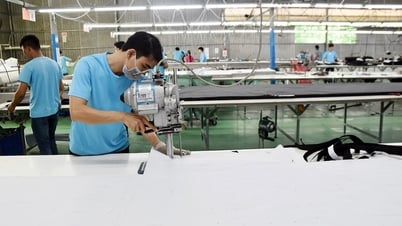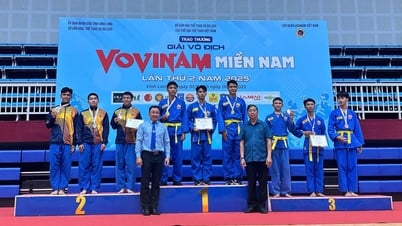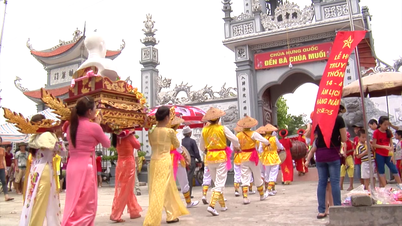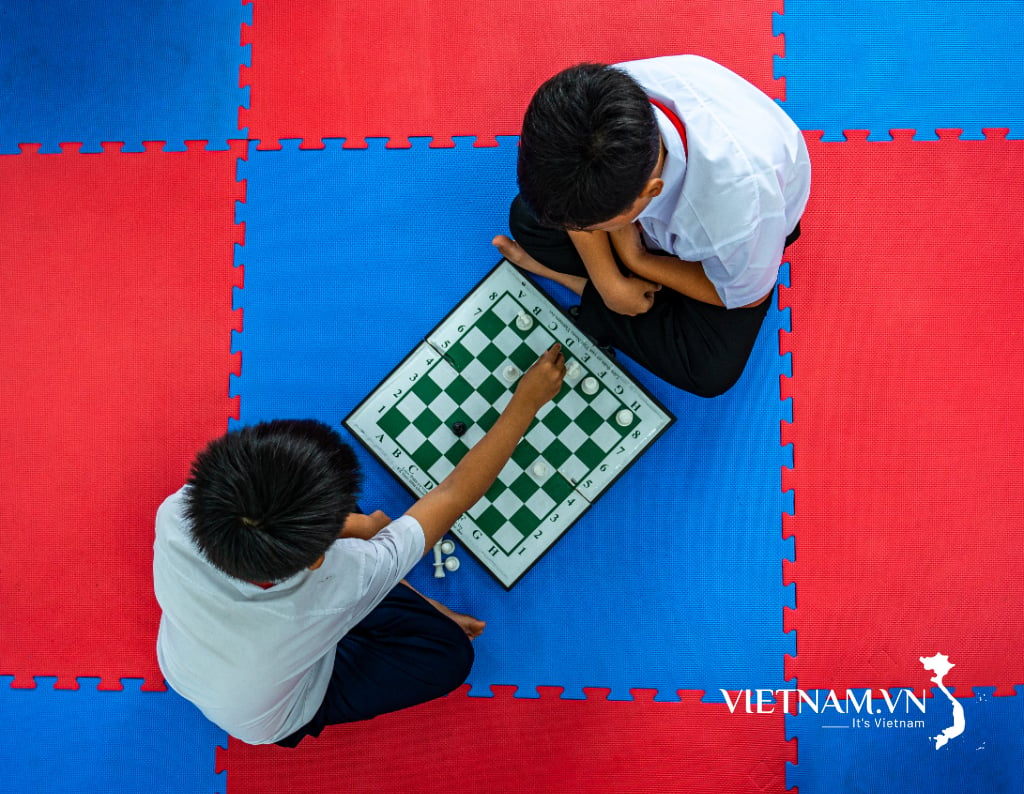
Despite her old age, every day Ms. Diep Thi Som (left) and her daughter weave mats, both to earn income and to preserve the local traditional craft.
The advantage of Ca Hom mats is their long-lasting durability, after 5-6 years the mats are still not brittle, broken or discolored. In particular, with the characteristics of the Khmer people's Southern Buddhist beliefs, Ca Hom mats with tower-shaped patterns (single tower, double tower, triple tower) are very popular with the Khmer people and they order these mats to offer to the pagoda on the occasion of the Kathyna robe offering ceremony, serving the festival activities at the pagoda.
In order to continue to do a good job of preserving and promoting the traditional cultural heritage values of the nation, implementing the direction of the Department of Culture, Sports and Tourism, from 2023, the Provincial General Museum will research, collect, collect documents, build a scientific dossier on Ca Hom mat weaving to submit to the People's Committee of Tra Vinh province to the Ministry of Culture, Sports and Tourism and be recognized and included in the List of National Intangible Cultural Heritage according to Decision No. 2321/QD-BVHTTDL, dated August 29, 2024 of the Ministry of Culture, Sports and Tourism.
According to records, Ca Hom mat weaving was formed in the late 19th century, from white mats. Initially, after a period of research and creativity, mat weavers learned to use dang and turmeric plants to create colors, dye sedge and weave cotton mats, with increasingly eye-catching patterns that were favored by many people and used as gifts and then became commodities from 1940. Over time, mat weaving gradually developed into a traditional profession of the Khmer people of Tra Vinh .
Having gone through many ups and downs due to competition from many other types of mats on the market, but with their love for the profession, many people in Ham Tan commune still persevere, preserving the core values of the mat weaving profession here. Being recognized as a National Intangible Cultural Heritage, the authorities and mat weavers are very happy with the hope that the craft village will continue to develop sustainably, helping to improve the lives of local people.
Artisan Diep Thi Som (76 years old), Ben Ba hamlet, Ham Tan commune shared: My family has been weaving mats for generations. When I was about 10 years old, I started helping my family split and dry sedge to make mats. By the age of 16, I had mastered all stages of making mats and have maintained this profession for decades. Therefore, when Ca Hom mat weaving village was listed as a national intangible cultural heritage, I was very happy.

Drying sedge is also a step that Ms. Diep Thi Som pays attention to in order to have beautiful sedge fibers to weave a durable, even, and shiny mat.
To have a pair of durable and beautiful mats, the mat makers in Ham Tan have a way to split the sedge and dry it so that the sedge stems curl beautifully so that the mats can be used for a long time. Furthermore, they need to have dyeing techniques to make them durable, beautiful and bright. When weaving, two workers are needed, one person stamps the mold and bends the edges, the other person puts the sedge into the loom. With Mrs. Diep Thi Som's family weaving mats every day with diligence, meticulousness and skill at every stage, so the woven mats are increasingly even, beautiful and eye-catching in color. In particular, her family weaves mats with beautiful letters and patterns, so many people order them as gifts to offer to the pagoda. For many years, her family has only woven mats according to orders and has daily work, with a stable income.
Ms. Diep Thi Som added: In the past, every day, my husband and I could weave 3 regular mats or 1 custom-made mat (1.2m wide and 5m long) to offer to the pagoda, a stable source of income to support 6 children. Now the children are grown up and all know how to weave mats, but only 2 children continue this profession. Now that we are old and in poor health, on average every 4-5 days, my youngest daughter and I can weave 1 custom-made mat (5m long) at a price of 1.5 million VND/piece.
Although Mrs. Tri Thi Thieu's household in Ca Hom hamlet does not have many orders, she and her daughter still continue to weave mats every day. Mrs. Tri Thi Thieu said: I weave about 15 days a month, earning 3.5-4 million VND. Although not much, it is suitable for the family's conditions of farming, weaving mats and taking time to take the children to school. Moreover, what I am happiest about is maintaining my family's traditional mat weaving profession and creating local specialty mat products for many people to order as gifts, especially during Khmer festivals.

Ms. Tri Thi Thieu has just completed a finished cotton mat according to order.
According to Mr. Huynh Ngoc Cat, Head of the People's Committee of Ca Hom Hamlet, about 50% of households in the hamlet know and used to make mats, but due to lack of a market, now only a few households still make the craft, mainly maintaining and promoting the traditional cultural beauty of the craft village.
Comrade Tang Duy Thong, Vice Chairman of Ham Tan Commune People's Committee, said: Although not strongly developed due to market competition, Ca Hom mat weaving has its own unique characteristics of the local Khmer people and has always been given attention for preservation. In 2001, with the desire to develop the craft village to help many ethnic households have stable jobs and improve their lives, Ham Tan Commune People's Committee supported funding for building weaving frames for 40 households in the craft village and invited artisan Ngo Thi Pho to teach the craft of weaving double-sided cotton mats.
Recently, the Department of Culture, Sports and Tourism and the TVU also coordinated to organize a mat weaving class to preserve the traditional beauty of mat weaving. Recognized as a national intangible cultural heritage, it helps to add confidence and motivation for the people of Ham Tan to maintain and promote the beauty of the unique traditional craft.
Currently, Ham Tan commune has only about 90 households still maintaining the mat weaving profession, of which, 04 households weave by machine and the remaining 07 machines weave by hand. Each year, the craft village supplies the market with about 40,000 pairs of mats of all kinds, of which cotton mats and lettered mats, although not in large quantities, are very popular, not only consumed in and outside the province but a few are exported to Cambodia. The majority of Ham Tan people want to keep the hand-weaving method using looms, determined to preserve the core values of the traditional Ca Hom mat weaving profession to pass on to their descendants, especially households weaving cotton mats with lettered letters.
According to Mr. Duong Hoang Sum, Director of the Department of Culture, Sports and Tourism of Tra Vinh province, the Ca Hom mat weaving craft of the Khmer people is the 8th national intangible heritage of Tra Vinh province and the first traditional craft heritage of the province to be included in this list. This is not only the pride of local people but also an important milestone in the journey of preserving and promoting the traditional cultural values of the Khmer community in the South, raising awareness of heritage preservation in the community. At the same time, it opens up many new opportunities for the craft village to develop, especially tourism development.
In the coming time, the Department's tourism sector will develop a plan to turn Ca Hom mat weaving into an attractive cultural tourism destination for visitors to the craft village to directly experience the mat weaving process, learn about the culture of the villagers... associated with solutions to preserve the heritage of mat weaving.
Article and photos: NGOC XOAN
Source: https://www.baotravinh.vn/kinh-te/dac-trung-van-hoa-nghe-det-chieu-ca-hom-46456.html

































































































Comment (0)